Table of contents
- Introduction
- The Pain Points
- SEP OmniLytics’ Mission
- Doing the Dirty Work, Providing Only Quality Data
- Setting Stringent Criteria
- Evaluating Essentiality and Quality
Introduction
The rise of LTE and 5G standard technology has led to the increased prominence of standard-essential patents (SEPs) in recent years.
Regarding SEPs, essentiality and over-declaration are the main issues most commonly debated. However, these issues stem from the most basic problem — transparency, or lack of transparency. The obscurity of the declared SEP landscape has led to an unbalanced position of power for SEP holders and implementors alike.
Both these prevalent issues in the SEP wild west lead to time-consuming and costly licensing negotiations for all parties involved, despite the FRAND term requirement. A licensing agreement normally takes 1 to 3 years to reach an agreement. Much time is spent in negotiations and expenses such as legal consultation or on other miscellaneous fees for traveling and accommodation during such negotiations. If the agreement breaks off or breaks down, the legal fees alone may reach US$ 10 million to 20 million for each case (consisting of approximately 5 ~ 20 patents). And this amount does not include damages!
Key Takeaway:
- A licensing agreement normally takes 1 to 3 years to reach an agreement.
- If the agreement breaks off or breaks down, the legal fees alone may reach US$ 10 million to 20 million for each case
What are the causes of this wild west SEP status? Can we look past the smoke to reveal the true SEP landscape? Let us look deeper.
Note: The term “SEP” used in SEP OmniLytics and mentioned in this article refers to standard essential patents declared under 3GPP standards in the ETSI IPR declaration database.
The Pain Points — Determining Essentiality & Quality and Acquiring Quality Data
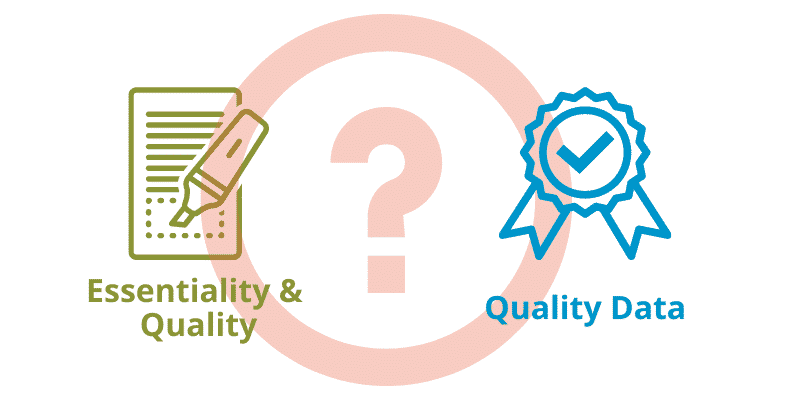
Essentiality & Quality
ETSI is currently the main source of SEP declaration data used due to its relative completeness in SEP data for 3GPP standards. However, it is crucial to note that ETSI SEP declarations are self-evaluations made by the declaring companies with no verification from any 3rd party. ETSI states SEPs as “any patent that might be essential” and their online database “allows, for information, public access to patents which have been declared as being essential or potentially essential…” This has lead to the over-declaration phenomenon that you can read more about in our dedicated article.
The common method of determining the essentiality or the quality of a declared SEP often relies upon claim charts and expert reviews. However, constructing a claim chart is often quite costly. If outsourced, the construction of a claim chart may cost US$ 100,000 to 150,000 per chart or more. This may not seem much at first glance, but you should consider the cost of an entire SEP portfolio or the entire SEP family.
Acquiring Quality Data
More importantly, the original documents submitted by declaring entities are often patchy and incomplete with missing or incorrect information. There is a high ratio of SEP declarations made by many companies that lacks relevant release information such as version number, release information, or project names. Patentcloud’s Data Science Team has also found many instances of typos or wrong information in the ETSI SEP declaration documents.
Numerous individuals and teams have spent who knows how long in coming up with search queries to find the SEP information they need. Not to mention digging up data that is later proven to be dirty and useless for any patent data analysis.
The process of sifting for quality SEP data requires much time and effort in combing through such “dirty” data. Acquiring quality data includes not just filtering out the “bad” data, but also filling in the gaps for missing or partial data. The nasty process includes data curating, cleansing, standardizing, ware-housing, verification, and integration.
For anyone in telecommunications and 5G, this means putting aside more labor and time just to filter out the noise and clear the smoke.
SEP OmniLytics’ Mission
Patentcloud’s SEP OmniLytics is purposed to alleviate the transparency issue that stems from the difficulties SEP owners and implementers face in determining the essentiality and quality of a standard essential patent and acquiring high-quality data.
SEP OmniLytics hopes to assist both SEP owners and implementers as the transparency issue becomes even more pronounced in the SEP licensing scenario. Not just the essentiality and quality of a SEP is of questionable value, ownership and legal statuses are also lacking in transparency. This has led and will continue to lead to countless disputes and international lawsuits.
To mitigate the transparency issue, high-quality data is, therefore, a necessity.
Doing the Dirty Work, Providing Only Quality Data
In light of the challenges faced, SEP OmniLytics strives to bring our users the most complete and best quality data through an evidence-based approach.
Patentcloud’s Data Science Team has built a comprehensive pipeline dedicated to cleanse and standardize the complex and incomplete source data. The latest ETSI SEP declarations are collected daily and the dirty data is then processed into reliable intelligence for further patent analysis.
Approximately nine thousand (9%) irrelevant and non-application declarations have been filtered out. These declarations do not correspond to any 3GPP standards or only correspond to standards already withdrawn by 3GPP.
SEP OmniLytics is also dedicated to maintaining 99%+ of all SEP declaration records, which is integrated with Patentcloud’s curated patent data for the latest asset status.
In addition, 98.6% of all SEP current owners have been standardized based on patent transfer data and corporate affiliates.
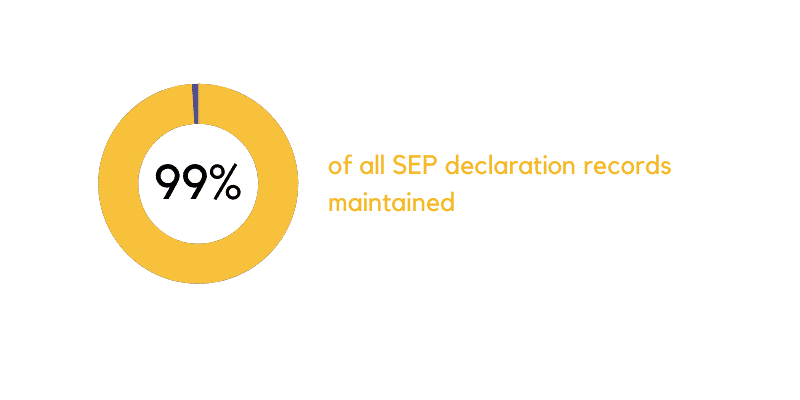
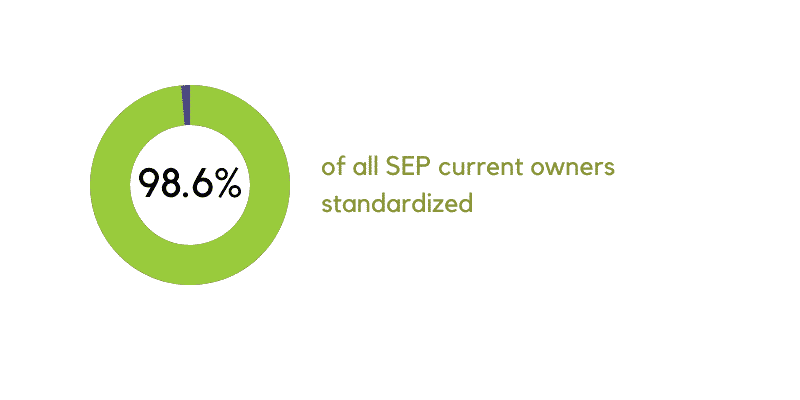
As a result, all of SEP OmniLytics’ dashboards are supported by comprehensive, timely, well-verified, and standardized data which our users can access directly.
Setting Stringent Criteria
Very strict criteria are set in SEP OmniLytics defining what constitutes a SEP declaration and how each radio technology is defined. All considerations taken in data adoption aim to retain data integrity, highlight essentiality, and prevent fueling the over-declaration situation.
Defining declared SEPs
In defining a standard essential patent, SEP OmniLytics adopts SEP declarations from the ETSI database and uses the elements in a SEP declaration to set the following criteria:
- The SEP must include technical report/specification information.
This includes (1) a 3GPP technical report/specification number and (2) whether the technical report/specification has been withdrawn or not. - The SEP must be a published patent application.
This is because only published applications have claims that can be further scrutinized for essentiality. Therefore, provisional and withdrawn applications are not included. - A SEP family must include patents with an ETSI declaration number and only include their simple family members.
SEP OmniLytics uses the EPO DOCDB simple family definition of “… a collection of patent documents that are considered to cover a single invention.”Simple families are used as the basic unit since:
(1) A patent that consists of the same technical content as a declared SEP implies that the patent is also a SEP.
(2) A SEP’s essentiality — commonly proven using a claim chart — does not necessarily indicate that its family members can also be proven thuswise.
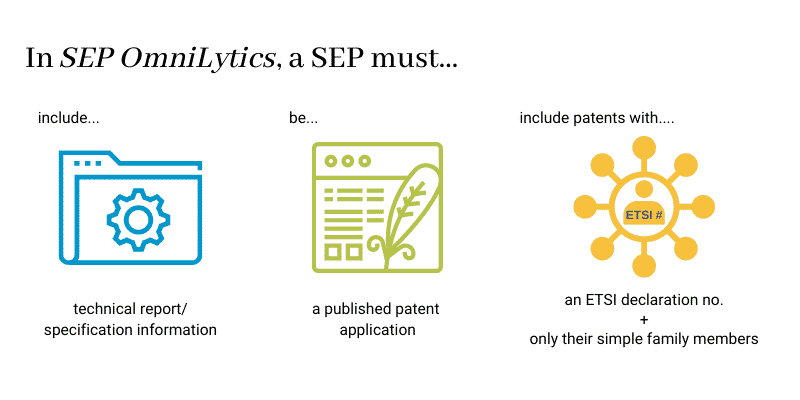
Standardizing Radio Technology
In SEP OmniLytics, the technical specification SEP landscape for 5G/LTE includes only SEPs that meet the following criteria:
- The technical specification must include at least one 3GPP specified 5G or LTE technical report/specification.
5G: release 15 ~17
LTE: release 8 and after
Each radio technology generation is specified by referencing the release versions, technical specification versions, and project names. - The release version is not available (N/A)
The N/A criterion is also included to compensate for any declaration that lacks relevant release information. - 5G: Declared on or after June 1, 2016 (R15)
LTE: Declared on or after January 23, 2003 (R8)
Theoretically, any declaration prior to the date of the 3GPP Release 15 for 5G and Release 8 for LTE is not considered to be a 5G/LTE application. This is under the assumption that no relevant technical specification exists before the specific release version of a certain generation.
Note: The project names on the original documents submitted are not considered as a single criterion. This is due to the possibility that a SEP declaration’s essentiality may be compromised if the criteria listed above are not met.
Evaluating Essentiality and Quality
Can SEP OmniLytics help evaluate the essentiality and quality of SEPs?
Yes! As mentioned before, claim charts and expert reviews are the most objective ways to examine the essentiality and quality of a SEP. Unfortunately, these methods are costly and arduous — not everyone can or is willing to invest in constructing claim charts or seeking expert opinions when conducting a preliminary assessment.
In light of these circumstances, SEP OmniLytics uses an evidence-based approach based on SEP owners’ behaviors and practices in viewing SEP data. This is done by observing SEP owners’ prosecution and maintenance behavior that revolves around their declared SEP portfolio and how such behavior reflects their self-evaluations.
Simply put, although SEP owners can make a SEP declaration just because they think their patent is essential, the declaration does not necessarily equal a truly essential patent. We examine this by looking at the SEP owners who have invested actual labor, cost, and time to achieve their self-evaluation results, and not just by simply making a declaration.
With this in mind, SEP OmniLytics instituted the “Widely Deployed,” “Well Maintained,” and “Newly Declared” filters.
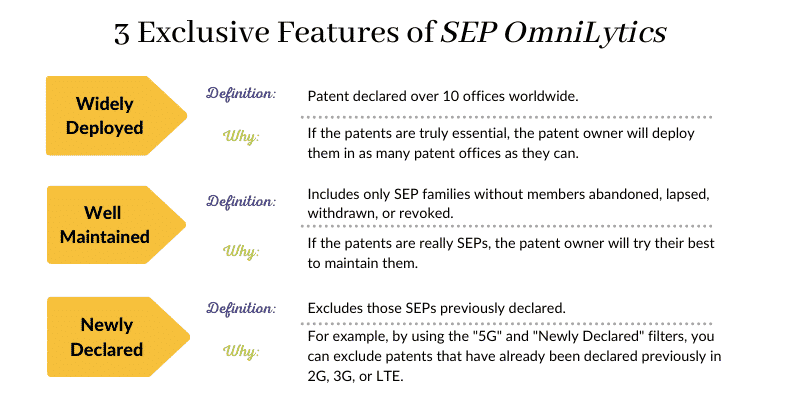
What is the Widely Deployed filter?
SEP OmniLytics’ Widely Deployed filter includes only declared SEP families having active or pending members in more than 10 jurisdictions. SEP families that are widely deployed reflect SEP owners’ continued investment in prosecution and maintenance fees. This thereby highlights the essentiality of the SEP declaration through the SEP owners’ actions.
What is the Well-Maintained filter?
SEP families in SEP OmniLytics without any abandoned, lapsed, withdrawn, or revoked members are viewed as “well-maintained.“ The Well Maintained filter highlights SEPs with higher quality and essentiality based on SEP owners’ self-evaluation. The statuses active members prove that SEP owners did not encounter challenges during prosecution that they were unable to overcome. They also show that the applications and maintenance of the SEP families were not abandoned due to quality or essentiality issues.
What is the Newly Declared filter?
The Newly Declared filter in SEP OmniLytics includes only SEPs not previously declared. This filter allows users to examine SEP declarations that were only declared during a specific radio technology generation, such as LTE or 5G.
Conclusion
Through diligent data scrubbing and easy-to-use visualized dashboards, Patentcloud’s SEP OmniLytics has provided our users with the best weapon to pierce through the veil of obscurity that surrounds the SEP landscape. With the best quality data and analysis, we hope the transparent data that SEP OmniLytics provides will reveal the true status of standard-essential patents, bringing transparency to any SEP licensing scenario — reducing everyone’s time, effort, and costs.
Patentcloud’s SEP OmniLytics gives you the latest SEP landscape overview with quality data and easy-to-read dashboards. Get started now!


